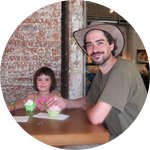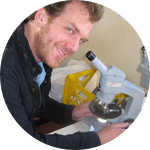About This Project
Viruses do more than just make us sick. Viruses are the most numerous organisms on the planet and they are everywhere, including soil. In the soil they can infect bacteria and other organisms that carry out important ecosystem functions, like nutrient cycling. It is likely that viruses have important effects on ecosystems, but we don't know exactly what that is! We hope to discover the role of viruses in the soil by identifying the viruses in a soil ecosystem.
Ask the Scientists
Join The DiscussionWhat is the context of this research?
Winogradsky columns are a simple, beautiful way to study the diversity and interactions within a microbial community. They are made by adding soil and a few supplements to a clear cylinder, and incubating in the light. Bacteria grow to fill different environmental niches, forming colorful colonies and performing all essential functions in the ecosystem. These columns have helped us to understand the various roles bacteria play in soil microbial communities – but viruses, too, play an important role. In our previous research we used Winogradsky columns to study communities in the soil, observing evidence that viruses may be killing off certain bacteria and allowing others to take their place.
What is the significance of this project?
As we learn more about microbial communities, we are increasingly recognizing the importance of these complex systems. Bacteria and viruses are all around (and even inside of) us, and understanding their interactions is an important step in understanding the world that we live in. These communities help us digest our food, cycle nutrients in the environment, and remove pollutants. However, these natural systems are extremely complex. Model systems are used in the lab to study complex natural systems on a smaller scale and with more control over variables. Establishing the Winogradsky column as a model microbial ecosystem will advance our understanding of viral ecology in soils. The conclusions can used to understand the more complex systems found in nature.
What are the goals of the project?
We already know what bacteria are present in Winogradsky columns and how they can change. What we don't know is what viruses are present and how they change. We plan to identify the Winogradsky "virome," the diverse community of viruses present, and how it changes over time as the bacterial community changes. Using DNA sequencing we will identify the rich diversity of viruses giving us a more complete picture of the members of this community. Using this data we hope to see the relationship between the changes in the bacterial community and viral community.
Budget
The bulk of our expenses will be to sequence all the viral DNA from the Winogradsky columns. DNA sequencing is a powerful technique that allows us to identify the viruses that are present, and their relative proportions. Due to the nature of viruses and the difficulty in studying unknown viruses in the lab, DNA sequencing is currently the only way to accurately describe the "virome," or viral community.
An ecologist can characterize the structure of the forest's ecosystem by observing and counting the plants and animals in the forest, watching a bee pollinating a flower, or see that one species is eating another. Microbial ecosystems are just as complex, with thousands of species interacting with each other. However, we can't directly observe how a viral or microbial community is structured: who is present, and how are they connected to the rest of the ecosystem? To do this, we have to look at the molecules present, like DNA.
Meet the Team
Team Bio
I started out with an interest in viruses and the diseases they cause. For many years, I studied poxviruses, viruses related to the virus that causes smallpox, a horrible disease that was thankfully eradicated. Then I learned that viruses were also found in every imaginable environment and were important to an ecosystem and it kind of blew my mind.
I came to Vassar because I love science but also love teaching. I get to teach fun classes and work with terrific, bright students. I teach classes on viruses, microbiology, epidemics, and zombie biology.
A few years ago I switched from studying poxes to studying bacteria in Winogradsky columns, and am thrilled that my interests have come together in studying viruses in Winogradsky columns. Students are involved in all parts of my research.
I was born in Canada, did my PhD in the USA, my post-doc back in Canada, and then moved back to the USA again. Outside the lab, I like to play lego or chess with my kids, and I can make a pretty good paella. I ran my first half marathon last year.
Maggie Ginoza is a Science, Technology, and Society major at Vassar College and has helped develop this project.
Jeff Werner is an Associate Professor at SUNY Cortland and has the mad computer skills to help us analyze all this data!
David Esteban
Im a scientist and teacher at Vassar College, a small liberal arts college in New York's Hudson Valley. Im interested in understanding bacterial and viral communities in the environment: basically, who's there and what are they doing?
Jeff Werner
Hi, I'm Jeff Werner. I'm an assistant professor in the Chemistry Department at SUNY Cortland. My research centers on using high-throughput molecular techniques like metagenomic sequencing and proteomics to investigate relationships between microbial community structure and function.
Press and Media

Internet, a new frontier for research funding (Miscellany News)
A Professor and His Research Intern: Going Viral (Vassar Office of Communications)

DIY Science: A Bacterial Garden (Buzzfeed)
Additional Information
Banner image: Bacteriophage by Kevin Gill
See more videos and information about my lab: http://pages.vassar.edu/viva/

Project Backers
- 65Backers
- 100%Funded
- $4,531Total Donations
- $69.71Average Donation


